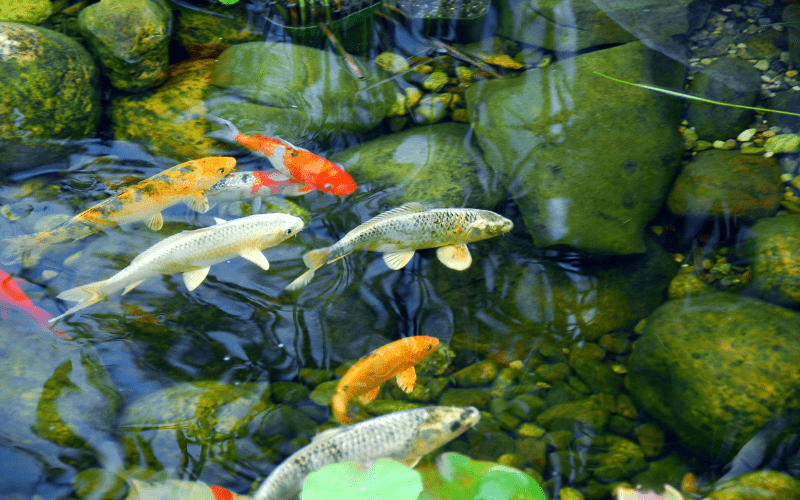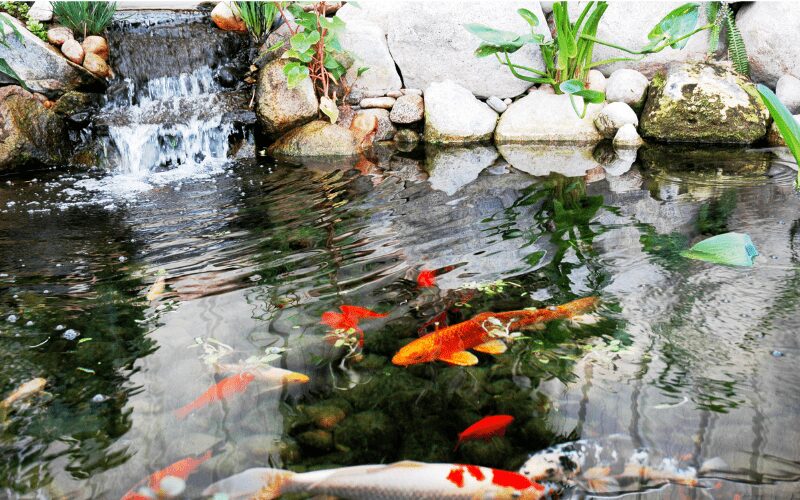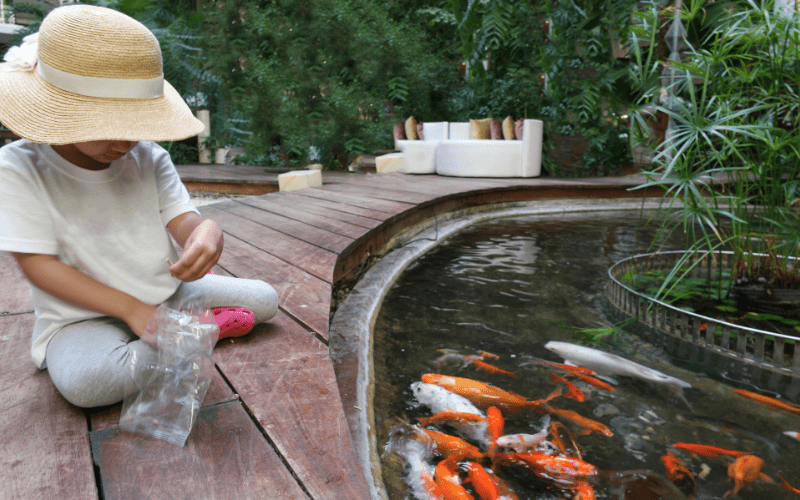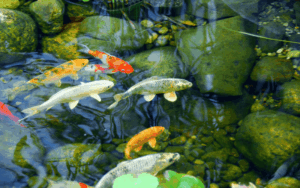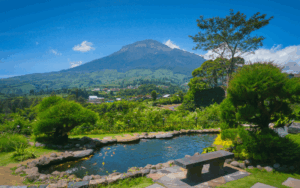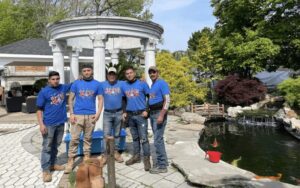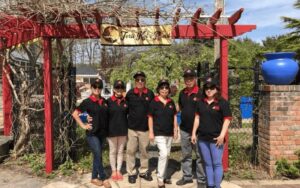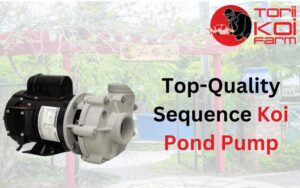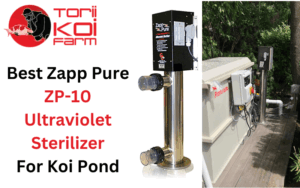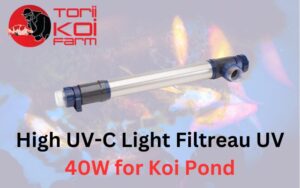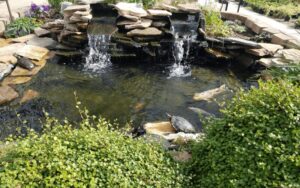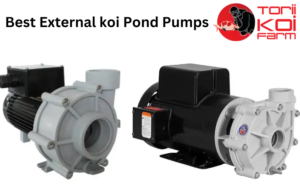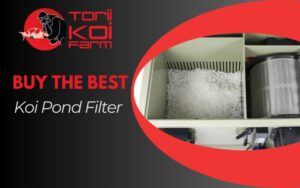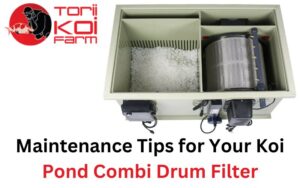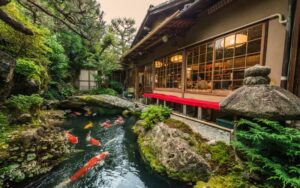Creating and maintaining a healthy koi pond ecosystem requires careful attention to water quality, plant balance, and fish nutrition. By providing the right environment, koi owners can ensure their pond remains not only visually appealing but also a safe, healthy habitat for their koi fish. Below, we cover essential tips for a balanced koi pond ecosystem that will support vibrant, healthy koi, beautiful plants, and clear, clean water. Torii Koi And Pond brings you this guide to maintaining your pond’s ecosystem in optimal shape.
Introduction to Koi Pond Ecosystems
A well-balanced koi pond ecosystem goes beyond the beauty of koi fish gliding through the water. It is a delicate balance of water quality, oxygen, beneficial bacteria, and plants working in harmony. When each component functions optimally, it leads to a stable ecosystem, fewer diseases, and happier koi. Regular pond care, attention to plant selection, and water quality monitoring are all part of maintaining this harmony.
Water Quality Management
Maintaining the right water quality is the foundation of a healthy koi pond ecosystem. Here’s how to manage it effectively:
- Optimal pH Levels: Koi ponds thrive at a pH level between 7.0 and 8.5. Test your water’s pH level regularly and adjust it as necessary. Avoid drastic pH shifts, which can cause stress for your koi.
- Proper Filtration: Choose a filtration system suited for your pond’s size and the number of koi. Mechanical filters remove debris, biological filters break down harmful toxins, and UV filters prevent algae growth. With the right filtration setup, your pond water will stay clear and safe.
- Routine Water Testing: Regularly test for ammonia, nitrite, and nitrate levels to ensure your pond’s water remains safe. Investing in a quality testing kit allows you to maintain these levels, protecting your koi from potentially harmful spikes.
Aeration and Oxygenation
Oxygen is essential for your koi and the beneficial bacteria that help balance your pond’s ecosystem. Without sufficient oxygen, koi can become stressed, and bacteria cannot process waste efficiently.
- Aeration Methods: Use air stones, fountains, or waterfalls to increase oxygen levels. These options are effective and provide an aesthetic touch to your pond. Aeration is especially crucial in warmer months when oxygen levels can drop.
- Seasonal Adjustments: Adjust aeration depending on the season. In winter, reduce aeration to prevent the pond from becoming too turbulent while ensuring there’s still enough oxygen for fish below the ice.
Aquatic Plants for Balance
Plants contribute to the ecosystem by absorbing nitrates, providing shade, and promoting oxygenation. Some ideal choices for koi ponds include:
- Floating Plants: Water lilies and water hyacinths not only beautify the pond but also help reduce algae growth by blocking sunlight.
- Submerged Plants: Anacharis and hornwort are excellent oxygenators. They add to the ecosystem by creating a natural filtration system.
Having a variety of plants in your pond contributes to both oxygen levels and a balanced nutrient cycle.
Managing Algae Growth
Algae, while natural, can quickly overtake a pond if not managed. Algae blooms create murky water and increase maintenance time, but there are ways to prevent overgrowth:
- Controlling Nutrients: Algae thrive on excess nutrients, especially from uneaten fish food and fish waste. Avoid overfeeding, and balance your koi population to prevent nutrient overload.
- Natural Algae Control: Adding plants, providing shade, and minimizing direct sunlight help control algae naturally.
- Algaecides: For serious algae issues, consider using an algaecide that is safe for koi and plants. Use it sparingly to avoid disrupting your pond’s natural balance.
Feeding and Nutrition for Koi Health
Feeding your koi a balanced diet promotes their health and helps reduce waste buildup in the pond.
- Balanced Koi Diet: Offer a high-quality koi food that contains a good mix of protein, vitamins, and minerals. Feed is based on the season, as koi eat more in warmer weather and require less food in colder months.
- Avoid Overfeeding: Excess food contributes to nutrient levels in the water, leading to algae growth. Feed small amounts and remove any uneaten food.
Seasonal Maintenance Routines
Adapting your maintenance routine to the seasons ensures the health of your koi and the stability of your pond ecosystem:
- Spring and Summer: Increased feeding, more plant growth, and higher algae levels call for more frequent cleaning and filtration checks. Test water frequently and ensure proper aeration.
- Fall and Winter: Reduce feeding, remove debris, and winterize equipment. Clean out decaying plants to minimize nutrient build-up that can cause issues in spring.
- Routine Checkups: Daily and weekly tasks, such as skimming debris, cleaning filters, and checking water quality, prevent problems before they start.
Beneficial Bacteria and Biofiltration
Beneficial bacteria play a vital role in the nitrogen cycle, breaking down waste into harmless substances and preventing ammonia and nitrite build-up.
- Adding Beneficial Bacteria: Regularly introduce beneficial bacteria into the pond, especially after filter cleanings. These bacteria support a balanced ecosystem and improve water quality.
- Maintaining Biofilters: Clean biofilters without killing the beneficial bacteria by rinsing them in pond water rather than chlorinated water.
Pest and Disease Prevention
Healthy koi are less susceptible to disease, but it’s essential to watch for common issues and prevent pests and illnesses from spreading.
- Identifying Signs of Illness: Watch for unusual behavior, white spots, or visible parasites on koi. Early detection is key to managing diseases.
- Safe Treatments: Use natural remedies or treatments that are safe for koi. Quarantine new fish before introducing them to prevent disease spread.
Pond Equipment and Tools
Maintaining the right equipment is key to a healthy koi pond ecosystem:
- Essential Tools: A quality pump, filter, aerator, and skimmer keep your pond’s ecosystem balanced.
- Routine Equipment Maintenance: Clean equipment regularly to prevent malfunctions. Check for wear and replace parts as needed to ensure everything runs smoothly.
Key Points for a Healthy Koi Pond Ecosystem
- Maintain balanced water quality by regularly testing and adjusting pH, ammonia, and nitrate levels.
- Keep oxygen levels high by using aeration methods like fountains and waterfalls.
- Use aquatic plants to manage nutrients and provide shade for koi naturally.
- Control algae growth by balancing nutrients and using safe algae control methods.
- Feed koi a balanced diet and avoid overfeeding to minimize waste.
- Adapt maintenance to the season, especially when temperatures change.
- Use beneficial bacteria to support biofiltration and water quality.
- Keep equipment clean and well-maintained for optimal pond function.
FAQs
Q1: What are the signs of a healthy koi pond ecosystem?
A1: Clearwater, vibrant and active koi, healthy plants, and minimal algae growth all indicate a healthy ecosystem.
Q2: How often should I test my koi pond water?
A2: Weekly testing of pH, ammonia, and nitrate levels is ideal, especially during seasonal changes.
Q3: How can I control algae in my koi pond naturally?
A3: Use aquatic plants to absorb nutrients, reduce direct sunlight exposure, and avoid overfeeding.
Q4: What’s the best type of plant for a koi pond?
A4: Floating plants like water lilies and submerged plants like hornwort are excellent for koi ponds, as they help oxygenate the water and provide natural filtration.
Q5: How do I prevent disease in my koi pond?
A5: Quarantine new fish, maintain good water quality, and use safe treatments when necessary to reduce the risk of disease.
Conclusion
By following these steps and regularly monitoring your pond, you can create a vibrant, balanced, and healthy environment for your koi. Consistent attention to water quality, feeding, and maintenance will ensure that your pond thrives year-round. Torii Koi And Pond is dedicated to helping koi owners maintain beautiful, healthy ponds and happy koi fish. For more advice or to shop for pond supplies, visit Torii Koi And Pond today.

